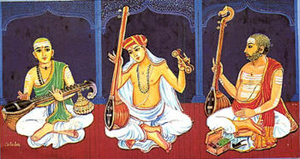|
 We know that Carnatic Music was originated from India, a country that is rich with culture and arts. The history says that Carnatic Music was documented in the Vedas. However, it is almost impossible to say a specific period or a form of music is the source of the present day contemporary Carnatic Music as there are changes taken place in the theory and the practice of the art. We know that Carnatic Music was originated from India, a country that is rich with culture and arts. The history says that Carnatic Music was documented in the Vedas. However, it is almost impossible to say a specific period or a form of music is the source of the present day contemporary Carnatic Music as there are changes taken place in the theory and the practice of the art.
The evolution of Carnatic Music can be traced from the historical records categorized as:
Source from Divine
In Indian culture, all forms of arts are believed to have divine origins. We could even see some deities like Krishna, Saraswati, Nandhi plays the flute, veena and the mridangam respectively. As such, the carnatic music is a blend of divine and art.
Source from Vedas
As said earlier, the Vedas could be a probable source of Carnatic Music. It has developed to a sophisticated system, as we know today, over the centuries. The Sama Veda, which is one of the four Vedas - Rig, Yajur, Sama, Atharvana, is said to have laid the foundation of the carnatic music. Sama Veda contain hymns from Rig Veda which have been set to musical tunes. These are used to be sung during a pooja (Vedic sacrifices/prayers).
Source from Folk
Many scholars had admitted that folk music is a source that influenced the carnatic music system. Although folk is a natural origin and has a spontaneous approach, carnatic music on the other hand, has a very systematic approach. Some folk tunes corresponds to carnatic music melodies eg; Sangkarabaranam, Punnagavarali, Charukesi, Anandabhairavi etc...
Source from Nature
If we observe carefully, the sounds produce by nature actually rhymes with the musical melody or notations of not only the carnatic music, but all forms of music in the world. It has been stated in ancient times the swara's (musical notation) are originated or abstracted in from the sounds of animals. Men has a distinguish ability to differentiate between different frequencies, timbre and qualities which are important factor of the evolution of carnatic music.
|